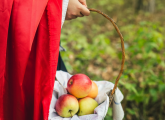It doesn’t matter if it’s raining and pouring, or the sun is beating down – there’s always something to learn about the elements, says Wendy Bowkett…
What a fitting day to write an article about weather. After a glorious weekend, I opened the curtains this morning to thundering rain on my windows and puddles everywhere. The cats won’t go out for their morning constitutional and are quietly sulking; they don’t do rain: it’s wet and usually means no outdoor play…
So do preschoolers need to know any more than cats do about rain? And if they do, how and when do you start a topic as vast as ‘the weather’? Well, I believe that under-fives need to know how weather and the climate affects living things all over the world, and what better way to start than by allowing children to experience it first hand?
Windy days are perfect for making simple kites and flying them outside, and could be your starting point. Foggy days are intermittent, so be prepared (if you work near the sea, hills or mountains, then you’ll be able to encompass misty/hazy days into your theme too). Waiting for a snowy day may mean that children have moved on to primary school before experiencing it for themselves, unless they have been skiing or tobogganing in the Alps or northern Scotland.
Rain, though, seems the ideal place to begin. We get plenty of it throughout Britain, so you won’t have to wait long. With rain, you can introduce ‘green issues’: does your setting have water butts to collect rainwater to use on your plants? If not, collect rain in buckets or bowls. Do you manage to save more water in a pot or a bucket? Why is this so? Plant seeds in different containers, water some regularly, some rarely and others not at all. What happens? These may seem obvious activities to us, but under-fives find them fascinating.
After discussing saving water at nursery and checking our water butts, Ben decided to experiment when he got home. He left his wellies in the garden with his dad’s watering can and mum’s ‘weed dustbin bag’ to see how much water could be collected. His wellies won the day because although the dustbin bag had a huge circumference, it wasn’t watertight and most of the rainwater seeped away. His wellies took several days to dry out, however, and that meant he was confined indoors more than he cared to be…
A topic on weather can produce many more experiments of this nature. Thermometers put in different places – on a sunny windowsill, in a dark cupboard, in a fridge, by a radiator, on the floor, above a display board – can be an excellent introduction to sun/heat safety. What differences can you see? Make ‘tracing paper’ masks to simulate lack of visibility in fog; how many thicknesses of tracing paper before it’s a real pea-souper?
Once, a child asked if rainbows, clouds and frost should be classed as ‘weather’. One of our quick-thinking three-year-olds replied, “Well, how could we get a rainbow without a bit of sun and dark rain clouds; that’s weather for you!” She didn’t have an answer for frosts as she wasn’t sure what frost was. However, it made us adults sit up and think: is a topic on weather only sun, wind, rain, fog and snow? What about hailstones, storms, ice, thunder and lightning?
Finally, when is the best time of year to start a theme on the weather, so that children might experience the whole range? A favourite poem is one by Wes Magee, ‘A Week of Winter Weather’, the gist of which is, Monday there’s icy rain, Tuesday the wind blows a gale, Wednesday has hail, Thursday is calm, Friday is frosty, Saturday foggy, and on Sunday the snow falls “like foam”. This would be a rare occurrence but makes for a good poem! There are many, many weather rhymes, songs and poems, as well as stories and picture books. Kipper’s book of the Weather by Mick Inkpen says it simply and effectively with perfect illustrations; Mrs Mopple’s Washing Line by Anita Hewett is a fun book, and our large wooden pig at nursery was often found wearing a petticoat from her washing line!
Weather can be such fun – puddle-jumping included!
Wendy Bowkett has worked in early years settings for over 30 years, and ran her own private day nursery for 15 years.

Traditional tales EYFS – What kids can learn from them
Editors picks

Story scribing – Building writers before they can write
Editors picks
